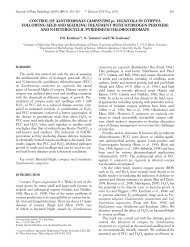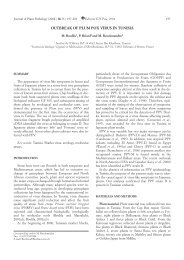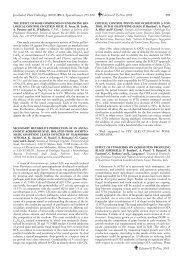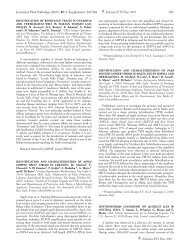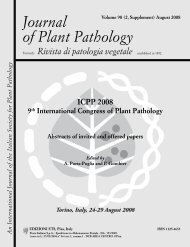Journal of Plant Pathology (2010), 92 (4, Supplement ... - Sipav.org
Journal of Plant Pathology (2010), 92 (4, Supplement ... - Sipav.org
Journal of Plant Pathology (2010), 92 (4, Supplement ... - Sipav.org
Create successful ePaper yourself
Turn your PDF publications into a flip-book with our unique Google optimized e-Paper software.
<strong>Journal</strong> <strong>of</strong> <strong>Plant</strong> <strong>Pathology</strong> (<strong>2010</strong>), <strong>92</strong> (4, <strong>Supplement</strong>), S4.71-S4.105 S4.95<br />
208, 33100 Udine, Italy. E-mail: rachele.polizzotto@uniud.it<br />
The genus Alternaria is characterized by a large spectrum <strong>of</strong><br />
plant-host interactions. It is therefore important to recognize and<br />
discriminate the pathogenic forms from the saprophytic or endophytic<br />
ones. It was reported that fungal endophytes recovered<br />
from symptomless natural hosts could cause severe symptoms<br />
when inoculated to other plant species. Since Alternaria endophytes<br />
from grapevine were effective in the biocontrol <strong>of</strong> Plasmopara<br />
viticola, both in pre- and post-infection treatments, the<br />
scope <strong>of</strong> this study was to investigate the behaviour <strong>of</strong> 12 Alternaria<br />
grapevine endophytic strains when artificially inoculated in different<br />
tissues <strong>of</strong> Vitis vinifera. Pathogenic assays were carried out<br />
using tomato (Solanum lycopersicum) as a nonhost test plant. A<br />
conidial suspension <strong>of</strong> each Alternaria obtained from single-spore<br />
cultures was sprinkled over six wounded leaves <strong>of</strong> grapevine and<br />
tomato seedlings. Grapevine and tomato berries were artificially<br />
inoculated by immersion (grapevine) or by wounding (tomato),<br />
using the Alternaria conidial suspension as above. Symptoms were<br />
evaluated 4 weeks after infection on leaves and one week on fruits.<br />
Re-isolation rate from inoculated tissues was estimated. Alternaria<br />
did not induce symptoms in inoculated leaves <strong>of</strong> both plant<br />
species, but was pathogenic (dark brown or black circular necrotic<br />
lesions) to tomato berries. Re-isolation frequency was 7% in<br />
grapevine and 41% in tomato. Results showed that Alternaria<br />
strains behave differently on the different plant tissues inoculated,<br />
as they are true endophytes <strong>of</strong> grapevine whereas they can cause<br />
severe damage to tomato berries.<br />
INFLUENCES OF CULTURAL PRACTICES ON BUNCH<br />
ROTS AND OCHRATOXIN A CONTAMINATION IN<br />
WINE. S. Pollastro 1 , C. Dongiovanni 2 , R.M. De Miccolis Angelini<br />
1 , P. Natale 2 , D. Perrelli 2 , F. Faretra 1 . 1 Dipartimento di Protezione<br />
delle Piante e Microbiologia Applicata, Università degli<br />
Studi “Aldo Moro”, Via Amendola 165/A, 70126 Bari, Italy. 2 Centro<br />
di Ricerca e Sperimentazione in Agricoltura “Basile Caramia”,<br />
Via Cisternino 281, Locorotondo (BA), Italy. E-mail: stefania.pollastro@agr.uniba.it.<br />
Grapevine bunch rots are a complex <strong>of</strong> diseases and alterations<br />
caused by several micr<strong>org</strong>anisms affecting the quality and<br />
safety <strong>of</strong> wine, as in the case <strong>of</strong> Aspergillus carbonarius. This fungus<br />
is the main responsible for ochratoxin A (OTA) contamination<br />
<strong>of</strong> grape and wine in the Mediterranean area. OTA is a mycotoxin<br />
frequently found in foods and beverages. The Reg. (EC)<br />
N. 123/2005 <strong>of</strong> 26.1.2005 established in 2.0 mg kg -1 the maximum<br />
tolerable limit <strong>of</strong> OTA in wine and other grape-juice derivatives.<br />
To improve the efficacy <strong>of</strong> IPM strategies in limiting bunch<br />
rots and OTA contamination, the role <strong>of</strong> some cultural practices,<br />
with particular regard to canopy and soil management, was evaluated<br />
on cv. Bombino nero in southern Italy. When shoot topping<br />
and tying-up were done at bunch closure, and were followed by<br />
leaf removal 20 days before vintage, all bunch rots were reduced,<br />
especially grey mould (100%), followed by A. carbonarius (50%)<br />
and OTA contamination (50%). Opposite results were obtained<br />
when canopy was abundant and almost free to grow. In this case,<br />
bunch rots, especially grey mould (+30%), A. carbonarius<br />
(+33%) and OTA contamination (+47%) were higher. The severity<br />
<strong>of</strong> bunch rots was high when grass-cut soil was in-between<br />
vine rows. A. carbonarius (+33%) and OTA contamination<br />
(+30%) also increased when ploughing between rows was carried<br />
out 20 days before vintage. Such findings suggest that a careful<br />
integrated management <strong>of</strong> both cultural practices and crop protection<br />
in vineyards is essential for reducing the risk <strong>of</strong> OTA contamination<br />
<strong>of</strong> wine.<br />
OBTAINMENT, CHARACTERIZATION AND FIRST AP-<br />
PLICATIONS OF A PHAEOMONIELLA CHLAMYDOSPO-<br />
RA BENZIMIDAZOLE-RESISTANT MUTANT IN EPI-<br />
DEMIOLOGICAL STUDIES. S. Pollastro, W. Habib, F. Faretra.<br />
Dipartimento di Protezione delle Piante e Microbiologia Applicata,<br />
Università degli Studi “Aldo Moro”, Via Amendola 165/A,<br />
70126 Bari, Italy. E-mail: faretra@agr.uniba.it.<br />
Studies on the fungal myc<strong>of</strong>lora <strong>of</strong> grapevine propagation materials<br />
showed a very high frequency <strong>of</strong> Phaeomoniella chlamydospora,<br />
which was also detected at different stages <strong>of</strong> the nursery<br />
propagation process. The availability <strong>of</strong> P. chlamydospora isolates<br />
carrying genetic markers easily detectable on semi-selective media<br />
can be helpful for clarifying: (i) the possible role <strong>of</strong> vine propagation<br />
steps in the contamination <strong>of</strong> vine materials; (ii) the transmission<br />
<strong>of</strong> Esca disease to new vineyards; (iii) the effectiveness <strong>of</strong><br />
control measures. Preliminarly, the response to benzimidazole<br />
fungicides (benomyl, carbendazim and thiophanate methyl) <strong>of</strong> 10<br />
wild-type isolates <strong>of</strong> P. chlamydospora was evaluated in colonygrowth<br />
and conidial-germination assays. Colony growth <strong>of</strong> all isolates<br />
was inhibited by 0.3-1 µg ml -1 <strong>of</strong> fungicides whereas conidial<br />
germination was poorly affected, although germ tubes appeared<br />
deformed and bent from 0.3 µg ml -1 a.i. Resistant mutants were<br />
selected on a medium additioned with 1 µg ml -1 benomyl or carbendazim<br />
(mutation frequency: 2.1-2.5×10 -8 and 1.4-2×10 -8 , respectively).<br />
Generally, mutants showed high resistance. The mutant<br />
C1.A43.2 (EC 50 >100 µg ml -1 ) was selected and used in preliminary<br />
experiments. Grapevine propagation material was artificially<br />
inoculated at different stages <strong>of</strong> the nursery process with<br />
conidia <strong>of</strong> the mutants and its ability to colonize wood tissues was<br />
verified 1-3 months after inoculation. The mutant was always<br />
reisolated from inoculated rootstocks and scions, even far away<br />
from the inoculation point, confirming the capability <strong>of</strong> P.<br />
chlamydospora to move in xylem vessels. The traceable mutant is<br />
being now applied in large-scale epidemiological studies on Esca<br />
disease.<br />
PRODUCTION OF AN ANTISERUM SPECIFIC TO CIT-<br />
RUS LEAF BLOTCH VIRUS. O. Potere 1 , M. Guardo 2 , A. De<br />
Stradis 3 , A. Caruso 2 , D. Boscia 3 . 1 Dipartimento di Protezione<br />
delle Piante e Microbiologia Applicata, Università degli Studi “Aldo<br />
Moro”, Via Amendola 165/A, 70126 Bari, Italy. 2 CRA, Centro<br />
di Ricerca per l’Agrumicoltura e le Colture Mediterranee, Corso<br />
Savoia 190, 95024 Acireale (CT) Italy. 3 Istituto di Virologia Vegetale<br />
del CNR,UOS Bari, Via Amendola, 165/A, 70126 Bari, Italy.<br />
E-mail: o.potere@agr.uniba.it<br />
Different Citrus species used as ornamentals and some trifoliate<br />
rootstocks were recently found infected by Citrus leaf blotch<br />
virus (CLBV), the type species <strong>of</strong> the genus Citrivirus, family<br />
Betaflexiviridae. This virus is currently detected by RT-PCR following<br />
nucleic acid extraction. For a faster virus detection from<br />
crude plant extracts, the feasibility <strong>of</strong> raising a CLBV-specific antiserum<br />
to be utilized for serological testing was investigated. To<br />
this aim, virus purification protocols were compared using several<br />
kinds <strong>of</strong> tissue (leaves, petioles and cortical scrapings) collected<br />
from Nagami kumquat and citron ‘Etrog’ in different seasons.<br />
Virus concentration was highest in spring, decreasing progressively<br />
as temperature arose. The successful mechanical transmission<br />
<strong>of</strong> CLBV to some herbaceous plants enabled the use <strong>of</strong> N.<br />
cavicola as host for virus propagation. Concentrated preparations<br />
<strong>of</strong> CBLV were evaluated by electron microscope before injecting<br />
them into a rabbit for immunization. The antiserum obtained<br />
decorated isolate ISA-10-CT-I particles used as inject antigen at a<br />
dilution <strong>of</strong> 1:20. Immunoglobulins (IgGs), purified from crude



